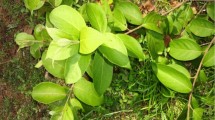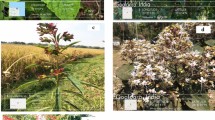This study was aimed to explore the potential of Pteris cretica L. to be used as herbal remedy. The P. cretica dried plant powder was subjected to a standard physicochemical (proximate analysis) protocol, which showed promising results and was consistent with the WHO recommended ranges that are required to use the plant as a remedy. To identify the bioactive chemical constituents of chloroform extract, the extract was subjected to a series of column chromatography and p-HPLC through the antibacterial and antioxidant bioassays guidance. The two most bioactive sub-fractions of chloroform extract were subjected to GC-MS analysis which revealed the presence of seventeen compounds, the major constituents being eicosane (16.8%), hexadecane (14.1%), methyl hexadecanoate (11.2%), 3,3,8-trimethyldecane (9.1%), 2,6,10-trimethyldodecane (7.8%), tricosane (5.1%) and tetradecane (3.86%). Proximate analysis results show that P. cretica plant is good for herbal remedy, and the bioassay results on chloroform fractions and sub-fractions show that this plant has significant antibacterial and antioxidant potentials. To use this plant as herbal remedy, there is need in further exploration.





Similar content being viewed by others
References
R. Bax, N. Mullan, J. Verhoef, Int. J. Antimicrob. Agents, 16(1), 51 – 59 (2000).
G. M. Cragg and D. J. Newman, Pharm. Biol., 39, 8 – 17 (2001).
R. S. Policegoudra, K. Rehna, L. J. Rao, et al., J. Biosci., 35(2), 231 – 240 (2010).
S. Vichi, K. Zitterl-Eglseer,M. Jugl, et al., Mol. Nutr. Food Res., 45(2), 101 – 104 (2001).
M. Raghavendra, S. Satish, and K. Raveesha, My Sci., 1(1), 72 – 78 (2006).
S. R. D. Paiva, M. R. Figueiredo, T. V. Aragao, et al., Mem. Inst. Oswaldo Cruz, 98(7), 959 – 962 (2003).
G. A. Cordell, Phytochemistry, 55(6), 463 – 480 (2000).
K. Pratibha, A. M. Otaghvari, H. Govindapyari, et al., Int. J. Med. Aromt. Plants, 1(1), 18 – 22 (2011).
B. B. Blažeković, S. Vladimir-Knežević, A. Brantner, et al., Molecules, 15(9), 5971 – 5981 (2010).
Z. Gazdik, B. Krska, V. Adam, et al., Sensors, 8(12), 7564 – 7570 (2008).
V. Diopan, P. Babula, V. Shestivska, et al., J. Pharm. Biomed. Anal., 48(1), 127 – 133 (2008).
K. Schlesier, M. Harwat, V. Bohm, et al., Free Radic. Res., 36(2), 177 – 187 (2002).
M. Sulc, J. Lachman, K. Hamouz, et al., Biol. Agric. Hortic., 26(1), 45 – 54 (2008).
G. T. Wondrak, N. F. Villeneuve, S. D. Lamore, et al., Molecules, 15(5), 3338 – 3355 (2010).
A. Zima, J. Hošek, J. Treml, et al., Molecules, 15(9), 6035 – 6049 (2010).
D. L. Madhavi, S. Deshpande, and D. K. Salunkhe, Food Antioxidants: Technological, Toxicological and Health Perspectives, CRC Press (1995).
T. I. B. Lopes, R. G. Coelho, N. C. Yoshida, et al., Chem. Pharm. Bull., 56(11), 1551 – 1554 (2008).
F. Saleem, M. T. J. Khan, H. Saleem, et al., Acta Pol. Pharm., 73, 1397 – 1403 (2016).
R. P. Adams, Identification of Essential Oils by Gas Chromatography/ Quadrupole Mass Spectroscopy, Allured Publ: Carol Stream, IL (2001).
T. Shibamoto and C. Bicchi, Retention Indices in Essential Oil Analysis, Huethig Verlag, New York (1987), Vol. 259, p. 74.
S. D. Sarker, L. Nahar, and Y. Kumarasamy, Methods, 42(4), 321 – 324 (2007).
B. Huang, H. Ke, J. He, et al., Food Chem. Toxicol., 49(1), 185 – 190 (2011).
K. C. Waterman, R. C. Adami, K. M. Alsante, et al., Pharm. Develop. Technol., 7(1), 1 – 32 (2002).
O. Folashade, H. Omoregie, and P. Ochogu, Int. J. Biodivers. Conserv., 4(3), 101 – 112 (2012).
Basic Tests for Drugs: Pharmaceutical Substances, Medicinal Plant Materials and Dosage Forms,World Health Organization (1998).
K. Ozarkar, Studies on Anti-Inflammatory Effects of Two Herbs: Cissus Qquadrangularis Linn. and Valeriana wallichii DC Using Mouse Model, PhD Thesis, University of Mumbai, Mumbai (2005).
C. N. Baker and F. C. Tenover, J. Clinic. Microbiol., 34(11), 2654 – 2659 (1996).
L. Collins and S. G. Franzblau, Antimicrob. Agents Chemother., 41(5), 1004 – 1009 (1997).
M. Pfaller and A. Barry, J. Clini. Microbiol., 32(8), 1992 – 1996 (1994).
W.-K. To, A. W. Fothergill, and M. G. Rinaldi, J. Clini. Microbiol., 33(10), 2660 – 2664 (1995).
R. K. Pettit, C. A. Weber, M. J. Kean, et al., Antimicrob. Agents Chemother., 49(7), 2612 – 2617 (2005).
Acknowledgments
The authors express their gratitude to the Faculty of Pharmacy, University of Lahore, Pakistan, and the International Center for Chemical and Biological Sciences (ICCBS), H. E. J. Research Institute of Chemistry, University of Karachi, Karachi, Pakistan for providing necessary research facilities.
Conflict of Interest
The authors declare that they have no conflicts of interest.
Author information
Authors and Affiliations
Corresponding author
Rights and permissions
About this article
Cite this article
Saleem, F., Mehmood, R., Khan, T.J. et al. Physicochemical and Bioassay Directed GC-MS Analyses of Chloroform Extract of Pteris cretica L.. Pharm Chem J 56, 387–395 (2022). https://doi.org/10.1007/s11094-022-02648-5
Received:
Published:
Issue Date:
DOI: https://doi.org/10.1007/s11094-022-02648-5




